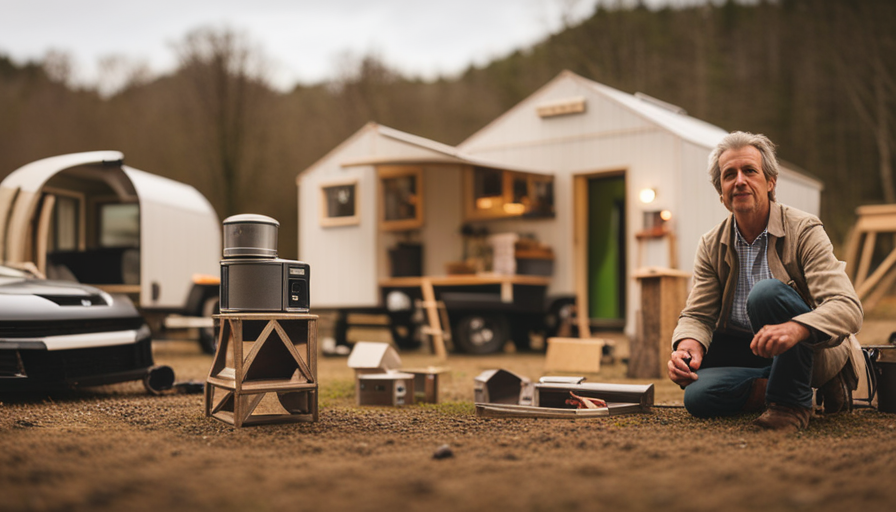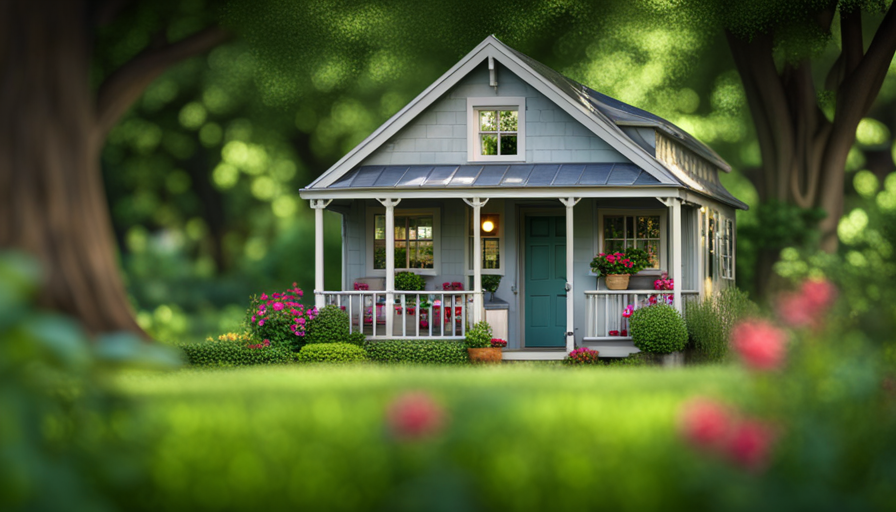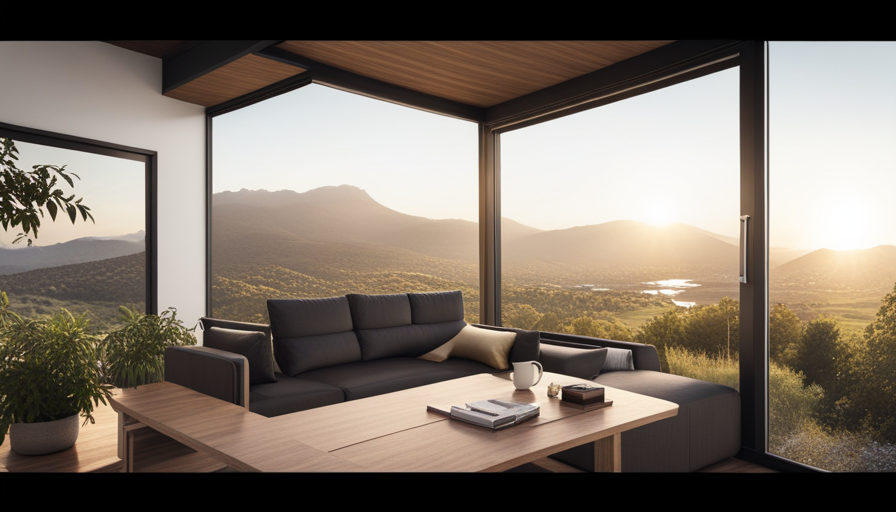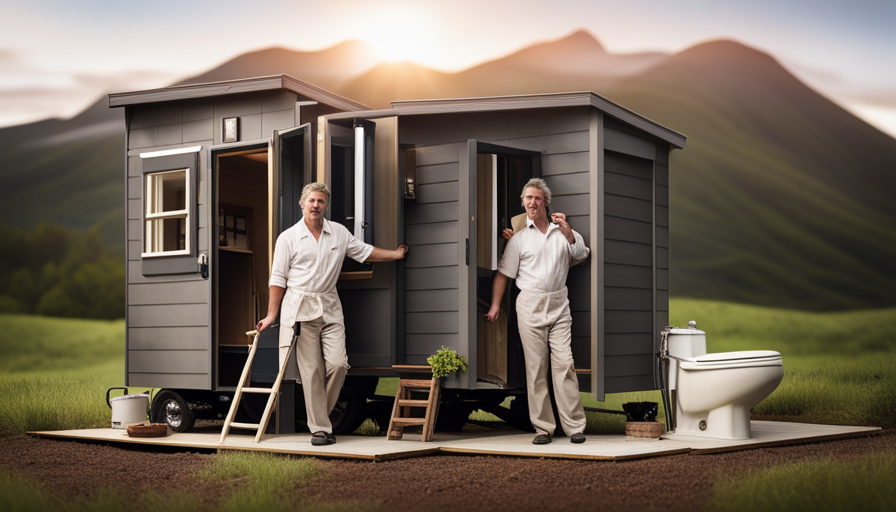One often finds that the greatest treasures come in small packages. This age-old wisdom is clearly demonstrated by the growing trend of tiny house communities. These neighborhoods offer a unique and environmentally friendly living choice for those who appreciate a minimalist lifestyle.
However, determining the amount of land needed to create a thriving tiny house village is no small feat. In this article, I will guide you through the essential factors to consider when calculating how many acres are needed for a tiny house village. From the number of houses in the village to common areas, parking spaces, utility infrastructure, setbacks, and zoning regulations – every aspect must be meticulously analyzed to ensure a successful and harmonious community.
Additionally, we will explore environmental impact and sustainability considerations, future expansion plans, as well as obtaining permits from local authorities. So join me on this informative journey as we delve into the fascinating world of creating a tiny house village that meets both practical needs and dreams of an alternative lifestyle.
Key Takeaways
- Determining the land needed for a thriving tiny house village is challenging due to factors such as the number of houses, common areas, parking spaces, utility infrastructure, setbacks, and zoning regulations.
- Environmental impact and sustainability considerations are important when planning a tiny house village, including waste management, recycling, and renewable energy options.
- Planning for future expansion and growth is crucial to meet the demand for affordable housing, and consulting with local authorities and obtaining permits is essential for a smooth expansion process.
- Seeking professional advice and guidance from experts familiar with permit procedures and local regulations is important to ensure compliance with building codes and health department regulations, and to avoid potential pitfalls.
Determine the Number of Houses in the Village
You’ll need to determine the number of houses in the village. This is an important step in planning a tiny house village, as it’ll help you determine how much land you’ll need.
The number of houses will depend on various factors such as the size of the land available and zoning regulations.
To start, consider the size of the village that you envision. Do you want a small community with just a few houses or a larger one with more homes? Think about what kind of atmosphere and sense of community you want to create. Once you have an idea of the desired village size, take into account any restrictions or guidelines set by local authorities.
Additionally, think about how much space each house will require. Tiny houses can vary in size, so consider whether you want all houses to be uniform or if there can be some variation. This’ll impact how many houses can fit on your chosen plot of land.
Once you have determined the number of houses, it’s time to consider the size of common areas and amenities. These spaces are essential for fostering a sense of community within your village.
By determining the number of houses in your tiny house village, you can begin to plan for other aspects such as common areas and amenities that’ll enhance the overall living experience for residents without overcrowding the space available.
Consider the Size of Common Areas and Amenities
Consider the size of communal spaces and amenities to ensure a harmonious flow within the community. When planning a tiny house village, it’s essential to allocate adequate space for common areas that foster social interaction and create a sense of belonging among residents.
These areas can include shared gardens, outdoor seating areas, community centers, or recreational facilities such as a playground or fitness center. The size of these common spaces will depend on the number of houses in the village and the expected population. It’s crucial to strike a balance between providing enough space for everyone to enjoy while avoiding overcrowding.
In addition to common areas, amenities play a significant role in enhancing the quality of life within the village. These amenities may include laundry facilities, storage units, mailboxes, and shared kitchens or dining areas. The provision of these amenities should be carefully considered based on the needs and preferences of the residents.
By carefully considering the size of common areas and incorporating suitable amenities in the village design, we can create an environment that promotes socialization and community engagement. This will contribute to a greater sense of well-being and satisfaction among residents.
To further enhance convenience for residents, it’s important to allocate space for parking and access roads within the village. This ensures easy movement throughout the community without congesting common areas.
Allocate Space for Parking and Access Roads
Ensure that there’s ample space for parking and convenient access roads throughout the community, allowing for easy movement without crowding common areas.
When designing the parking layout for a tiny house village, it’s important to consider the number of houses and residents to determine the appropriate amount of parking spaces needed. Each tiny house should have its own designated parking spot to ensure that residents have a place to park their vehicles without taking up space in common areas.
In addition to providing enough parking spaces, it’s also crucial to design the access roads in a way that allows for smooth traffic flow within the village. The roads should be wide enough to accommodate two-way traffic and provide easy maneuverability for larger vehicles such as moving trucks or emergency vehicles. Regular road maintenance should be conducted to ensure that they remain safe and functional for residents.
By allocating sufficient space for parking and designing well-maintained access roads, we can create a community where residents can easily move around without hindering others or causing congestion in common areas.
As we transition into discussing utility infrastructure and services, it’s essential to account for these factors when planning the layout of a tiny house village.
Account for Utility Infrastructure and Services
When planning the layout, it’s important to account for utility infrastructure and services in order to create a functional and convenient community for residents. Properly allocating space for utility infrastructure ensures that residents have access to essential services such as water, electricity, and sewage disposal. Here are five key considerations when accounting for utility infrastructure and services:
-
Water Supply: Ensuring an adequate water supply is crucial for the tiny house village. This includes planning for a reliable source of clean water and designing a distribution system that can meet the needs of all residents.
-
Electrical Grid: Designing an efficient electrical grid is essential to provide power to each tiny house. This involves considering the capacity requirements, installing transformers, and planning for future expansion.
-
Sewage System: Implementing an effective sewage system is important to maintain sanitation within the village. Proper waste disposal facilities should be planned, including septic tanks or connections to municipal sewer lines.
-
Waste Management: A well-designed waste management system is necessary to promote cleanliness and hygiene. This may include designated recycling areas, trash collection points, and composting facilities.
-
Telecommunications: Providing reliable internet and phone connectivity enhances the quality of life in the village. Considering options like fiber optic cables or wireless networks helps ensure seamless communication among residents.
In addition to accounting for utility infrastructure and services, it’s crucial to factor in setbacks and zoning regulations when planning the layout of a tiny house village. This ensures compliance with local laws while creating a harmonious living environment for all residents.
Factor in Setbacks and Zoning Regulations
While setbacks and zoning regulations may pose challenges, incorporating them into the layout of a compact community ensures compliance with local laws and creates a harmonious living environment for all residents. Setbacks refer to the minimum distance that buildings must maintain from property lines or other structures. Zoning regulations, on the other hand, dictate how land can be used within a specific area. These guidelines are put in place to protect the safety and well-being of communities.
Ensuring legal compliance is crucial when establishing a tiny house village. By carefully considering setbacks and zoning regulations during the planning phase, potential obstacles can be identified and addressed early on. This may involve adjustments to building placement or design to meet setback requirements, as well as adhering to zoning guidelines for residential areas.
In addition to legal compliance, setbacks and zoning regulations also offer an opportunity for community engagement and neighborhood integration. By working closely with local authorities and residents, a tiny house village can be designed in a way that respects the existing character of the surrounding area while providing much-needed affordable housing options.
Transition: With setbacks and zoning regulations accounted for, the next step is to evaluate the topography and terrain of the land…
Evaluate the Topography and Terrain of the Land
Consider the unique contours and landscape of your chosen plot, as it’ll greatly influence the overall design and functionality of your compact community. Before finalizing the site for your tiny house village, it’s crucial to evaluate the land suitability by assessing its topography and terrain.
The topography of the land plays a significant role in determining the number of acres needed for a tiny house village. Steep slopes or uneven terrain may limit construction options and require additional steps to ensure stability. For example, if the land has a steep slope, you might need to level it or build retaining walls to create usable space for housing units.
Additionally, evaluating the topography can help assess construction costs. Working with natural features such as hills or vegetation can offer opportunities for creative design solutions while minimizing expenses. However, potential challenges like rocky soil or poor drainage should also be taken into account when estimating construction costs.
Understanding these factors will guide you in making informed decisions about how many acres are needed for your tiny house village. Once you have evaluated the topography and terrain, you can move on to assessing the environmental impact and sustainability of your project without compromising functionality.
[Transition Sentence: Moving forward, it’s essential to assess the environmental impact and sustainability of your proposed tiny house village.]Assess the Environmental Impact and Sustainability
In assessing the environmental impact and sustainability of a tiny house village, two key points that need to be considered are waste management and recycling, as well as renewable energy options.
Proper waste management practices will ensure that the village is able to minimize its environmental footprint and promote a cleaner, healthier living environment.
Additionally, exploring renewable energy options such as solar or wind power can help reduce reliance on non-renewable resources and contribute to a more sustainable community.
Overall, these considerations are crucial in ensuring the long-term viability and ecological responsibility of a tiny house village.
Waste Management and Recycling
With efficient waste management and recycling systems, a tiny house village can be an eco-friendly haven on just a few acres of land. Waste reduction is a key component of these systems, as it minimizes the amount of garbage produced in the first place. By implementing strategies such as composting toilets, organic waste can be transformed into nutrient-rich compost for gardens and landscaping within the village.
Recycling is also crucial in ensuring that materials are reused instead of ending up in landfills. Residents can participate in recycling programs for paper, plastics, glass, and metals to minimize their environmental footprint. Additionally, implementing a community-wide sorting system makes recycling convenient and accessible to all residents.
With effective waste management and recycling practices in place, a tiny house village can promote sustainability while utilizing limited space efficiently.
Transition: Now let’s explore renewable energy options for powering these eco-friendly tiny homes without relying on traditional sources of energy.
Renewable Energy Options
Renewable energy options can power these sustainable homes, ensuring that they aren’t reliant on traditional sources of energy.
Solar power is one such option that can be utilized in a tiny house village. By installing solar panels on the roofs of each tiny house, residents can harness the power of the sun to generate electricity for their daily needs.
Additionally, incorporating wind turbines into the design of the village can further supplement the energy requirements. These turbines can capture the wind’s kinetic energy and convert it into electricity, providing an additional source of renewable energy.
By integrating both solar power and wind turbines into the village’s infrastructure, we can create a self-sustaining community that minimizes its carbon footprint while still meeting its energy needs.
This focus on renewable energy sets the stage for future expansion and growth as we continue to prioritize sustainable practices.
Plan for Future Expansion and Growth
To ensure future expansion and growth, you’ll need to consider a plan for how many acres are needed for your tiny house village. As the demand for affordable housing continues to rise, it’s important to anticipate the need for additional units in the future. By carefully planning for future expansion, you can avoid potential setbacks and ensure the long-term success of your village.
Growth planning involves assessing the current needs of your community and projecting future population growth. Consider factors such as population trends, job opportunities, and local amenities that may attract more residents to your area. Additionally, think about any potential changes in zoning regulations or building codes that may affect the size and layout of your village.
By determining how many acres are required for each unit and common areas, you can estimate how much land will be needed for future development. It’s essential to leave room for new construction while still maintaining a comfortable living environment for existing residents.
Consult with local authorities and obtain permits to understand any restrictions or requirements regarding land use. This will help you navigate through legal processes smoothly when expanding your tiny house village.
Consult with Local Authorities and Obtain Permits
Make sure you consult with local authorities and secure the necessary permits to ensure a smooth expansion process for your community. Obtaining permits is crucial as it ensures compliance with local regulations and mitigates potential legal issues that may arise in the future. Before starting any construction or development, it is important to understand the permit requirements specific to your location.
To provide you with a clearer idea of what you might encounter, here is a table summarizing some common permit requirements and local regulations:
| Permit Requirements | Local Regulations |
|---|---|
| Zoning Approval | Setbacks |
| Building Permits | Maximum Height |
| Utility Connections | Parking |
Zoning approval is essential as it determines whether your tiny house village is allowed in the chosen area. Setbacks regulate how close structures can be built to property lines or other buildings. Building permits ensure that all structures meet safety standards set by local building codes. Utility connections cover water, sewage, and electrical hookups necessary for each unit. Lastly, parking regulations dictate the number of parking spaces required per unit.
Remember, these are just examples, and actual permit requirements may vary depending on your location.
In order to navigate through this process successfully, seeking professional advice and guidance from experts familiar with permit procedures and local regulations can greatly assist in obtaining the necessary approvals smoothly. Transitioning into seeking professional advice will further streamline your expansion plans without unnecessary delays or complications.
Seek Professional Advice and Guidance
Navigating through the complex permit process can feel like wandering through a dense forest, but seeking professional advice and guidance is like having a knowledgeable guide who can lead you out to the clearing of approvals smoothly. When it comes to determining how many acres are needed for a tiny house village, it is crucial to consult with professionals who have expertise in zoning regulations and land use planning.
They can provide valuable insights into the legal requirements and help you make informed decisions. Professional advisors such as architects, urban planners, or real estate consultants can assess your specific needs and objectives. They will take into account factors such as the number of houses, common areas, parking spaces, and any additional amenities desired for the village. By considering these variables along with local regulations, they can determine an estimate of the land area required.
Additionally, seeking professional guidance ensures that you comply with all legal requirements related to building codes and health department regulations. These experts stay up-to-date on current laws and policies that may affect your project. Their knowledge helps minimize potential setbacks or delays during the permit application process.
Relying on professional expertise when determining how many acres are needed for a tiny house village is essential. They possess the necessary knowledge regarding legal requirements and zoning regulations to ensure a successful project implementation while avoiding potential pitfalls along the way.
Frequently Asked Questions
What are the specific setbacks and zoning regulations that need to be considered when planning a tiny house village?
When planning a tiny house village, it’s crucial to consider setbacks and zoning regulations.
Setbacks refer to the minimum distance that must be maintained between structures and property lines.
Zoning regulations dictate land use and determine where and how tiny houses can be placed within a community. These rules ensure safety, aesthetics, and proper utilization of space.
Community engagement is also essential in considering the needs and concerns of residents when developing these regulations.
How can the topography and terrain of the land affect the design and layout of a tiny house village?
Topography considerations play a crucial role in the design and layout of a tiny house village. The terrain of the land can greatly impact the placement and orientation of the houses, as well as overall accessibility and privacy.
For instance, steep slopes may require more creative solutions for foundation and infrastructure, while flat areas could allow for easier construction. These factors need to be carefully analyzed to ensure an efficient and harmonious village layout that maximizes space utilization.
What are the potential environmental impacts of building a tiny house village, and what sustainability measures can be implemented?
The potential environmental impacts of building a tiny house village include increased waste generation, resource consumption, and habitat disturbance. However, sustainability measures can be implemented to mitigate these effects.
For example, incorporating renewable energy sources, such as solar panels and rainwater harvesting systems, can reduce the carbon footprint. Additionally, promoting community engagement through shared spaces and gardens encourages sustainable practices and fosters a sense of collective responsibility.
These measures not only address environmental concerns but also have potential economic benefits for the community.
What are some important factors to consider when planning for future expansion and growth of a tiny house village?
When considering the future expansion and growth of a tiny house village, there are several important factors to take into account.
Expansion considerations include assessing the availability of land, zoning regulations, and infrastructure requirements.
Growth factors involve analyzing the demand for housing, community needs, and potential economic impacts.
It’s crucial to carefully plan and strategize in order to ensure sustainable development and successful long-term growth of the village.
What are the necessary permits and approvals that need to be obtained from local authorities in order to establish a tiny house village?
To establish a tiny house village, several permit requirements and local regulations need to be met.
These may include obtaining zoning permits, building permits, and land use approvals from the local authorities.
Zoning permits ensure compliance with the designated land use category, while building permits guarantee that construction meets safety standards.
Additionally, land use approvals assess factors such as density and infrastructure requirements.
Adhering to these permit requirements and local regulations is crucial for establishing a legally compliant tiny house village.
Conclusion
In conclusion, determining the acreage needed for a tiny house village requires careful consideration of various factors. From assessing the number of houses to planning for future growth, it’s essential to consult with local authorities and seek professional advice.
By taking into account setbacks, zoning regulations, and environmental impact, we can ensure sustainable development. The allocation of space for common areas and amenities enhances the community’s well-being.
Ultimately, obtaining permits and adhering to regulations will pave the way for a thriving village that fosters a sense of belonging and sustainability in its residents.
Hi, I’m Emma. I’m the Editor in Chief of Tiny House 43, a blog all about tiny houses. While tree houses are often associated with childhood, they can be the perfect adult retreat. They offer a cozy space to relax and unwind, surrounded by nature. And since they’re typically built on stilts or raised platforms, they offer stunning views that traditional homes simply can’t match. If you’re looking for a unique and romantic getaway, a tree house tiny house might just be the perfect option.










